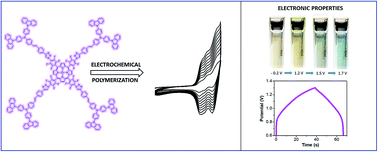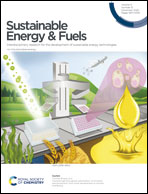Electrosynthesis of a hyperbranched dendrimeric porphyrin polymer: optical and electronic characterization as a material for bifunctional electrochromic supercapacitors†
Abstract
A Zn(II) porphyrin monomer modified by four fully π-conjugated side-branches holding eight carbazole residues produces a hyperbranched polymeric conducting film by electrochemical polymerization. The polymer possesses electronic properties that make the film suitable for application in energy storage devices as a supercapacitive material. This property is based on the pseudocapacitance generated by the reversible redox processes that can be induced in the organic polymeric film. The open dendrimeric structure allows the formation of a sponge-like tridimensional arrangement, with a large contact area between the liquid electrolyte and the film surface. The pseudocapacitive electrode material exhibits capacitances as high as 277 F g−1 at a current density of 4.5 A g−1, and presents a specific capacitance retention of 70% at 54.5 A g−1. This high capacitance retention demonstrates that the organic polymer could be used as a material for energy storage applications where a high discharge–recharge rate is needed. Also, the electrochromic behavior of the porphyrin polymer may be used in transparent devices where charge discharge processes are followed by color changes.



 Please wait while we load your content...
Please wait while we load your content...